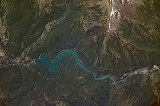
Pangue Hydroelectric Plant
Encyclopedia
Pangue Hydroelectric Plant is a hydroelectric power station in Bío-Bío Region
, Chile
. It lies west of Callaqui
volcano at the confluence of the rivers Pangue and Huiri-Huiri. The plant uses water from the upper Bío-Bío River
and produces 467 MW of electricity
. The plant was built by Endesa
in 1996.
delivering water to the power plant has a hydraulic head of 103 m and a design volume of 500 m³/second. Pangue contributes 10% of the electricity fed into the Chilean integrated grid, making it the third larges power station after Ralco (640 MW) and Pehuenche (500 MW). The dam is made of roller-compacted concrete
, using about a million cubic meter of concrete. The dam and power plant were built from 1993 to 1996. Behind the dam lies a reservoir of 500 hectares, 14 km long and 360 m wide. This makes it one of the most efficient large hydropower plants in the world, as measured by the relation between electricity production and area flooded. The construction of Pangue, just as the one of Ralco, generated controversies between environmentalists, the Government and the private power company Endesa
, because the dam impacted the indigenous Pehuenche
people, whitewater rafting areas and the rights of farmers further downstream.
Bío-Bío Region
The VIII Biobío Region , one of the fifteen first-order administrative divisions in Chile, comprises four provinces: Arauco, Biobio, Concepción, and Ñuble.The capital of the Region is Concepción...
, Chile
Chile
Chile ,officially the Republic of Chile , is a country in South America occupying a long, narrow coastal strip between the Andes mountains to the east and the Pacific Ocean to the west. It borders Peru to the north, Bolivia to the northeast, Argentina to the east, and the Drake Passage in the far...
. It lies west of Callaqui
Callaqui
Callaqui is a stratovolcano located in the Bío-Bío Region of Chile. It is a large ice-capped, basaltic andesite volcano which is elongated in the northeast-southwest direction, due to its construction along an 11 km long fissure. Numerous cinder cones and lava flows have erupted from...
volcano at the confluence of the rivers Pangue and Huiri-Huiri. The plant uses water from the upper Bío-Bío River
Bío-Bío River
The Biobío River is the second largest river in Chile. It originates from Icalma and Galletué lakes in the Andes and flows 380 km to the Gulf of Arauco on the Pacific Ocean....
and produces 467 MW of electricity
Electricity
Electricity is a general term encompassing a variety of phenomena resulting from the presence and flow of electric charge. These include many easily recognizable phenomena, such as lightning, static electricity, and the flow of electrical current in an electrical wire...
. The plant was built by Endesa
Endesa (Chile)
Endesa Chile is the largest electric utility company in Chile. It was created as a subsidiary of the state-owned CORFO in 1 December 1943 and was privatized in 1989. As of April 2009, it is owned by Enersis with a 60% stake, which in turn is 61% owned by Endesa International SA, a wholly owned...
in 1996.
Technical features
The penstockPenstock
A penstock is a sluice or gate or intake structure that controls water flow, or an enclosed pipe that delivers water to hydraulic turbines and sewerage systems. It is a term that has been inherited from the technology of wooden watermills....
delivering water to the power plant has a hydraulic head of 103 m and a design volume of 500 m³/second. Pangue contributes 10% of the electricity fed into the Chilean integrated grid, making it the third larges power station after Ralco (640 MW) and Pehuenche (500 MW). The dam is made of roller-compacted concrete
Roller-compacted concrete
Roller-compacted concrete or rolled concrete is a special blend of concrete that has essentially the same ingredients as conventional concrete but in different ratios, and increasingly with partial substitution of fly ash for Portland cement. RCC is a mix of cement/fly ash, water, sand, aggregate...
, using about a million cubic meter of concrete. The dam and power plant were built from 1993 to 1996. Behind the dam lies a reservoir of 500 hectares, 14 km long and 360 m wide. This makes it one of the most efficient large hydropower plants in the world, as measured by the relation between electricity production and area flooded. The construction of Pangue, just as the one of Ralco, generated controversies between environmentalists, the Government and the private power company Endesa
Endesa (Chile)
Endesa Chile is the largest electric utility company in Chile. It was created as a subsidiary of the state-owned CORFO in 1 December 1943 and was privatized in 1989. As of April 2009, it is owned by Enersis with a 60% stake, which in turn is 61% owned by Endesa International SA, a wholly owned...
, because the dam impacted the indigenous Pehuenche
Pehuenche
Pehuenches are an indigenous people that are part of the Mapuche peoples and live in the Andes in south central Chile and Argentina. Their name derives from their habit of harvesting of piñones, the seeds of the Araucaria araucana or pehuén...
people, whitewater rafting areas and the rights of farmers further downstream.

